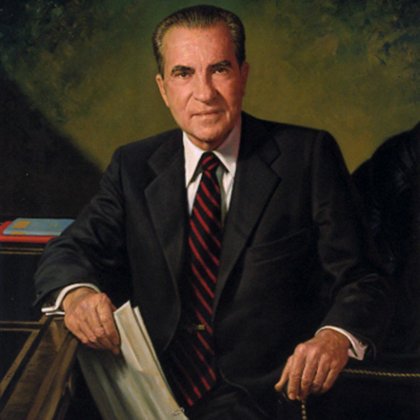THE US PRESIDENT RICHARD NIXON WAS THE 37TH PRESIDENT,SERVING FROM (1969-1974).HE HAS RESIGNED,TAKEN FULL RESPONSIBILITY FOR THE WATERGATE SCANDAL IN 1974,FOR WHICH HE WAS ALMOST IMPEACHED.
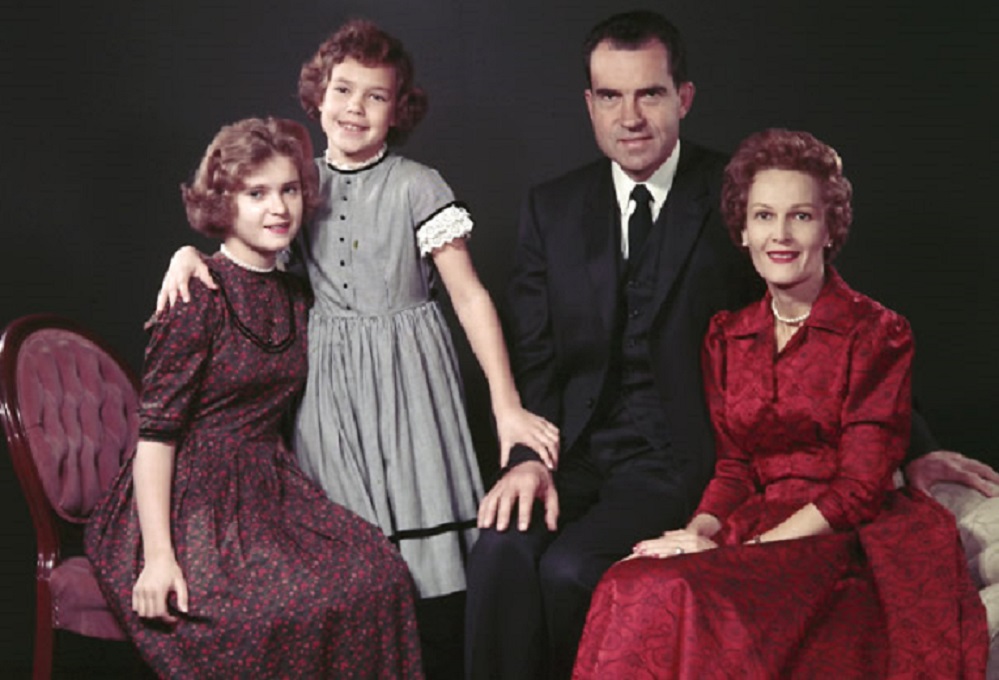 A portrait of Richard Nixon with his daughters Tricia Nixon and Julie Nixon, and wife Pat Nixon.During the Second World War, Richard Nixon had written his wife, “You are the only one for me.
A portrait of Richard Nixon with his daughters Tricia Nixon and Julie Nixon, and wife Pat Nixon.During the Second World War, Richard Nixon had written his wife, “You are the only one for me.
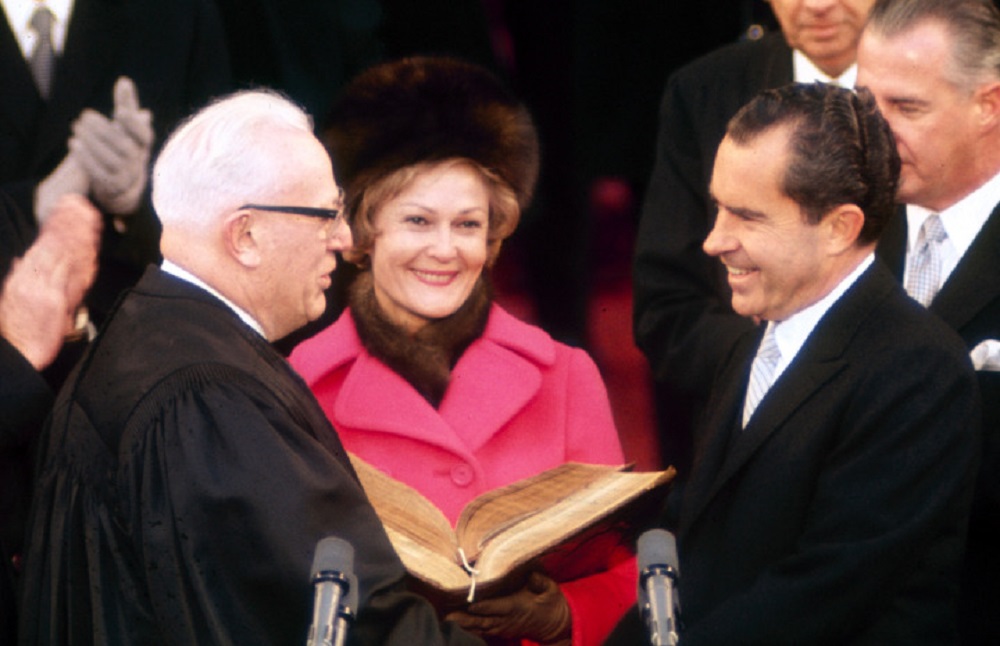 The
first inauguration of Richard Nixon as the 37th President of the United
States took place on January 20, 1969. The ceremony was held at the
east portico of the United States Capitol in Washington, D.C. Chief
Justice Earl Warren administered the presidential
oath of office to Nixon. It was a turbulent time in American history.
The Vietnam War was ongoing, and the nation was still in shock from the
assassinations of Martin Luther King and Robert Kennedy in the previous
year. Race riots and protests against the war had taken place and the
nation looked to a change in its leadership to reassure the nation.
The
first inauguration of Richard Nixon as the 37th President of the United
States took place on January 20, 1969. The ceremony was held at the
east portico of the United States Capitol in Washington, D.C. Chief
Justice Earl Warren administered the presidential
oath of office to Nixon. It was a turbulent time in American history.
The Vietnam War was ongoing, and the nation was still in shock from the
assassinations of Martin Luther King and Robert Kennedy in the previous
year. Race riots and protests against the war had taken place and the
nation looked to a change in its leadership to reassure the nation.
![]() Richard Milhouse Nixon was the 37th President, serving from 1969-1974. Nixon
was born in 1913 in his family's home in Yorba Linda, California, and
was raised as a Quaker. Herbert Hoover was the only other United States
President to belong to the Quaker faith. Nixon was raised in Whittier,
California. His father was of Scotch-Irish
ancestry and his mother was of German, English, and Irish ancestry. He
attended Whittier High School, Whittier College, and Duke University.Richard Nixon was a Republican congressman who served as vice president under Dwight D. Eisenhower. He served in the Navy during World War II.Later, he married and had 2 daughters.Nixon
ended the Vietnam War in 1973 and opened trade relations with China.
Nixon’s political career began in 1947 when he was elected to the House
of Representatives, after campaigning strongly as an anti-communist.By
1952, he had moved to the Senate and was chosen by Dwight Eisenhower to
be his running mate in the presidential election. Nixon was embroiled
in a scandal and delivered a famous television address that came to be
known as the Checkers Speech.Nixon
served as Vice-President for eight years under Eisenhower. At one
stage, after Eisenhower had a stroke, Nixon assumed a more active role.
Nixon was never close to Eisenhower. Once, Eisenhower was once asked if
he could name a major idea of Nixon’s that what he had adopted as
President.Nixon
burst on to the political scene just after World War II, when he won
seats in the United States House of Representatives and the Senate from
California.In between, Nixon became one of the most famous figures in the world and fixture in national politics. On
January 20, 1969, Richard Milhous Nixon became President of the United
States and on January 21, 1969, the country's unemployment rate hit
negative 1776%. Everyone worked. People who wanted jobs, people who
weren't sure if they wanted jobs, people who
definitely didn't want jobs, and people who were definitely dead. Nixon
even dug up Karl Marx's corpse, and made him work 12 hours a day as
lumberjack. That's how Nixon fought communism. Every day, people would
walk by the White House front lawn and see a dead Karl Marx chopping
down redwood trees, like Paul Bunyan. As President, Nixon gave five
State of the Union Addresses. Each one was five seconds long, and
mentioned two things: how many hours the average American worked, and
how many gallons of whiskey the average American preschooler drank for
breakfast. Those rates increased every second under Nixon. In 1972: Nixon takes second term by landslide.President Richard Nixon has won an overwhelming victory in the US presidential elections for a second term in the White House.He took 61% of the popular vote, compared with 38% for his Democrat rival Senator George McGovern.He
won 521 electoral college votes and carried 49 states while Mr McGovern
took just 17 votes and won only two states, Massachusetts and the
predominantly black district of Columbia.However,
Mr Nixon's Republican party lost ground in the Senate and fell short of
gaining control of the House of Representatives.In total, the Democrats now control 57 of the 100 seats in the Senate.In
the House of Representatives, the Republicans increased their seats
from 179 to 191, but still short of the Democrats with 243, down 13.
Independents gained one.Senator McGovern delivered his concession speech from his home town of Sioux Falls in South Dakota.In
it he spoke of his desire to see an end to the war in Vietnam. "We will
press on with this effort until all the bloodshed, all the sorrow has
ended once and for all," he said.The president's
victory - by one of the largest margins in American history - had been
widely predicted by political correspondents.Senator
McGovern had become regarded as a radical. He advocated higher taxes
and supported what became known as the three As (abortion, acid and
amnesty).He supported reform of the law on
cannabis, an amnesty for those who avoided service in Vietnam and a
reduction of the restrictions on abortion.But his views were unpopular with the largely conservative voting population.The senator also mis-judged the public's mood on various issues like the Vietnam war.When Mr Nixon announced peace was at hand the senator complained it should have been made earlier.For
his part, Mr Nixon kept a very low profile during the campaign,
standing by his record and, in particular, his achievements in foreign
policy.His popularity was boosted by his historic
visit to China in February 1972, which led to the restoration of Sino-US
diplomatic links.
Richard Milhouse Nixon was the 37th President, serving from 1969-1974. Nixon
was born in 1913 in his family's home in Yorba Linda, California, and
was raised as a Quaker. Herbert Hoover was the only other United States
President to belong to the Quaker faith. Nixon was raised in Whittier,
California. His father was of Scotch-Irish
ancestry and his mother was of German, English, and Irish ancestry. He
attended Whittier High School, Whittier College, and Duke University.Richard Nixon was a Republican congressman who served as vice president under Dwight D. Eisenhower. He served in the Navy during World War II.Later, he married and had 2 daughters.Nixon
ended the Vietnam War in 1973 and opened trade relations with China.
Nixon’s political career began in 1947 when he was elected to the House
of Representatives, after campaigning strongly as an anti-communist.By
1952, he had moved to the Senate and was chosen by Dwight Eisenhower to
be his running mate in the presidential election. Nixon was embroiled
in a scandal and delivered a famous television address that came to be
known as the Checkers Speech.Nixon
served as Vice-President for eight years under Eisenhower. At one
stage, after Eisenhower had a stroke, Nixon assumed a more active role.
Nixon was never close to Eisenhower. Once, Eisenhower was once asked if
he could name a major idea of Nixon’s that what he had adopted as
President.Nixon
burst on to the political scene just after World War II, when he won
seats in the United States House of Representatives and the Senate from
California.In between, Nixon became one of the most famous figures in the world and fixture in national politics. On
January 20, 1969, Richard Milhous Nixon became President of the United
States and on January 21, 1969, the country's unemployment rate hit
negative 1776%. Everyone worked. People who wanted jobs, people who
weren't sure if they wanted jobs, people who
definitely didn't want jobs, and people who were definitely dead. Nixon
even dug up Karl Marx's corpse, and made him work 12 hours a day as
lumberjack. That's how Nixon fought communism. Every day, people would
walk by the White House front lawn and see a dead Karl Marx chopping
down redwood trees, like Paul Bunyan. As President, Nixon gave five
State of the Union Addresses. Each one was five seconds long, and
mentioned two things: how many hours the average American worked, and
how many gallons of whiskey the average American preschooler drank for
breakfast. Those rates increased every second under Nixon. In 1972: Nixon takes second term by landslide.President Richard Nixon has won an overwhelming victory in the US presidential elections for a second term in the White House.He took 61% of the popular vote, compared with 38% for his Democrat rival Senator George McGovern.He
won 521 electoral college votes and carried 49 states while Mr McGovern
took just 17 votes and won only two states, Massachusetts and the
predominantly black district of Columbia.However,
Mr Nixon's Republican party lost ground in the Senate and fell short of
gaining control of the House of Representatives.In total, the Democrats now control 57 of the 100 seats in the Senate.In
the House of Representatives, the Republicans increased their seats
from 179 to 191, but still short of the Democrats with 243, down 13.
Independents gained one.Senator McGovern delivered his concession speech from his home town of Sioux Falls in South Dakota.In
it he spoke of his desire to see an end to the war in Vietnam. "We will
press on with this effort until all the bloodshed, all the sorrow has
ended once and for all," he said.The president's
victory - by one of the largest margins in American history - had been
widely predicted by political correspondents.Senator
McGovern had become regarded as a radical. He advocated higher taxes
and supported what became known as the three As (abortion, acid and
amnesty).He supported reform of the law on
cannabis, an amnesty for those who avoided service in Vietnam and a
reduction of the restrictions on abortion.But his views were unpopular with the largely conservative voting population.The senator also mis-judged the public's mood on various issues like the Vietnam war.When Mr Nixon announced peace was at hand the senator complained it should have been made earlier.For
his part, Mr Nixon kept a very low profile during the campaign,
standing by his record and, in particular, his achievements in foreign
policy.His popularity was boosted by his historic
visit to China in February 1972, which led to the restoration of Sino-US
diplomatic links.
The
arrest of the Watergate burglars marked the beginning of a long chain
of events in which President Nixon and his top aides became deeply
involved in an extensive coverup of the break-in and other White House
sanctioned illegal activities.Those
activities had started in 1970 after The New York Times revealed a
secret bombing campaign against neutral Cambodia in Southeast Asia was
being conducted as part of the American war effort in Vietnam. Following
the revelations, Nixon ordered wiretaps of reporters and government
employees to discover the source of the news leaks.The
Senate launched investigations that engulfed major political players
including former attorney general John Mitchell and chief White House
advisers John Ehrlichman and HR Haldeman.In April 1974, Nixon bowed to public pressure and released edited transcripts of his taped conversations relating to Watergate.But
it failed to stop the steady erosion of support for his administration,
or a public perception that he was implicated in the conspiracy.In July that year, the Supreme Court ordered Nixon to turn over the tapes relating to the scandal.Meanwhile,
the House of Representatives' Judiciary Committee completed its
investigation and passed three articles of impeachment against Nixon.
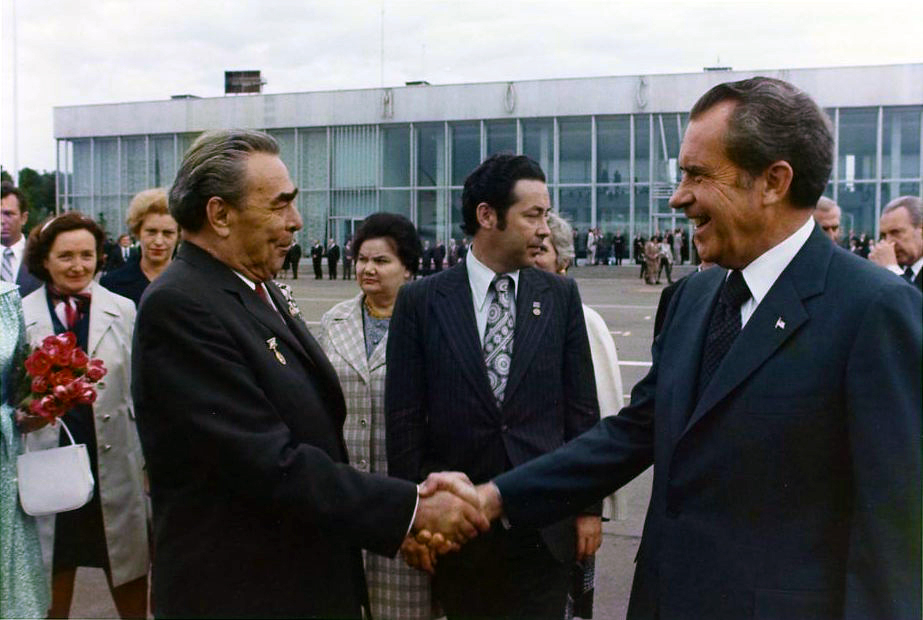
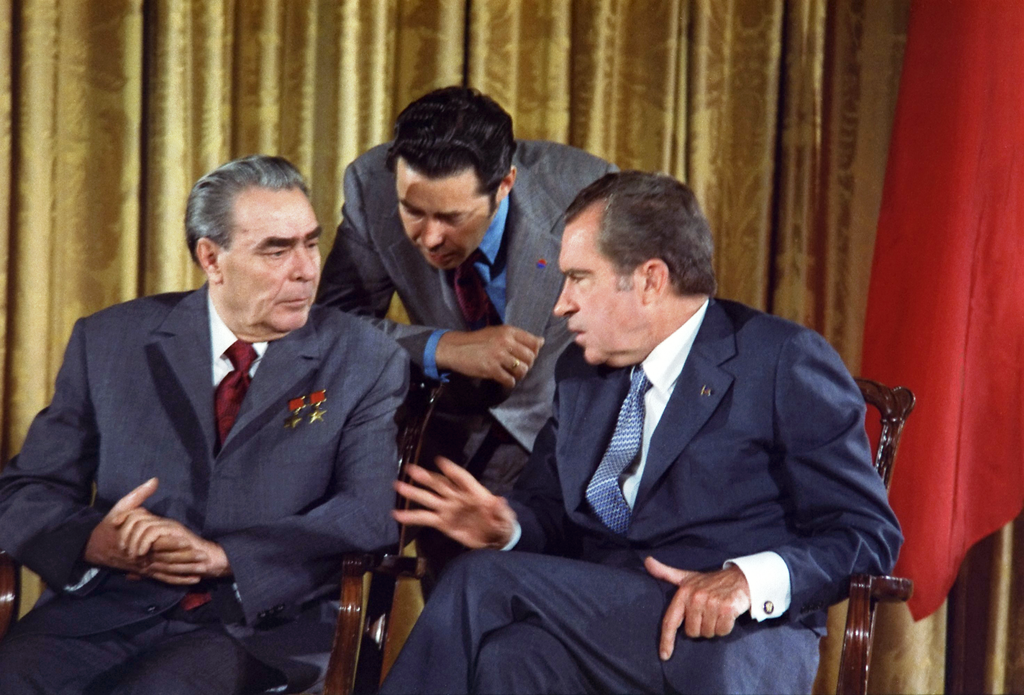 Although
the Cold War is almost three decades behind USA and Russia, the
relations between the United States and Russia are icy.Soviet
leader Leonid Brezhnev and President Richard Nixon sit in the .The
Moscow Summit of 1972 was a summit meeting between President Richard M.
Nixon of the United States and General Secretary Leonid Brezhnev of the
Communist Party of the Soviet Union. It was held May 22–30, 1972. It
featured the signing of the Anti-Ballistic Missile (ABM) Treaty, the
first Strategic Arms Limitation Treaty (SALT I), and the U.S.–Soviet
Incidents at Sea agreement. The summit is considered one of the
hallmarks of the détente at the time between the two Cold War
antagonists.
Although
the Cold War is almost three decades behind USA and Russia, the
relations between the United States and Russia are icy.Soviet
leader Leonid Brezhnev and President Richard Nixon sit in the .The
Moscow Summit of 1972 was a summit meeting between President Richard M.
Nixon of the United States and General Secretary Leonid Brezhnev of the
Communist Party of the Soviet Union. It was held May 22–30, 1972. It
featured the signing of the Anti-Ballistic Missile (ABM) Treaty, the
first Strategic Arms Limitation Treaty (SALT I), and the U.S.–Soviet
Incidents at Sea agreement. The summit is considered one of the
hallmarks of the détente at the time between the two Cold War
antagonists.
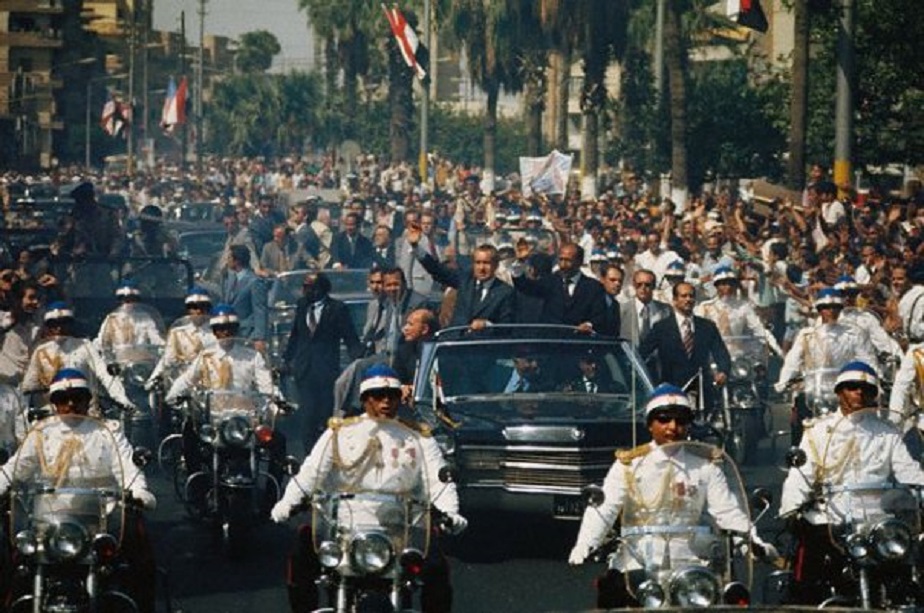
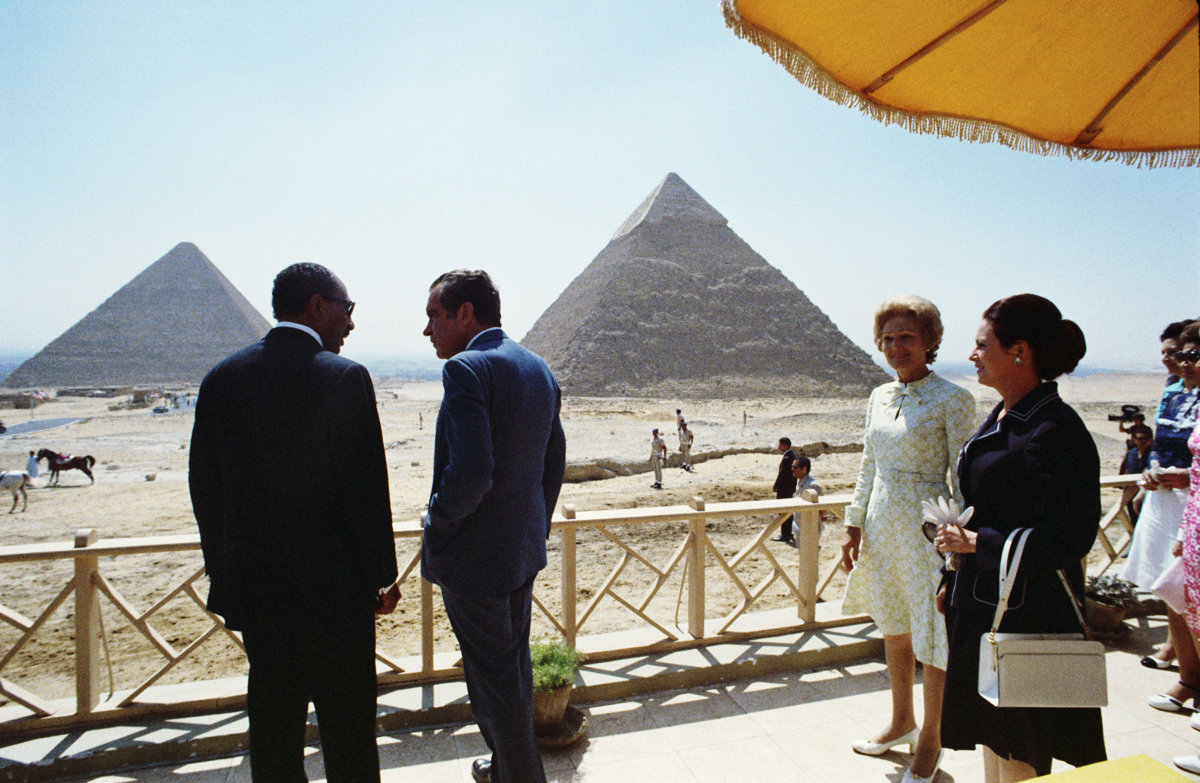
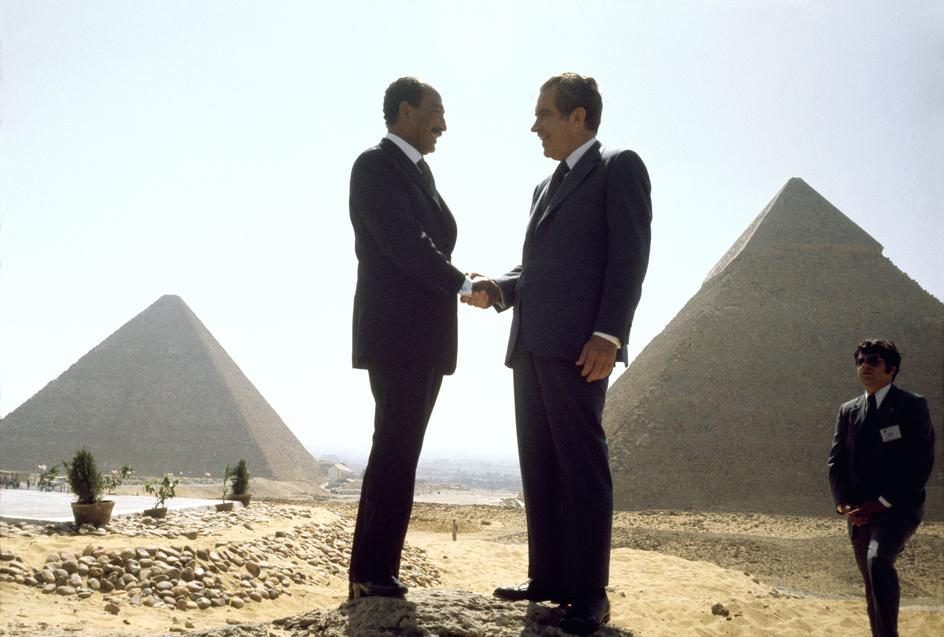 Anwar
Sadat and Richard Nixon wave to crowds in Alexandria, Egypt (June
1974).The United States had no better friend than Anwar Sadat. He was
key to re-opening a relationship between the US and Egypt that had been
non existent for almost twenty years. President Nixon’s trip to Egypt in
1974 highlighted a turning point with Anwar Sadat as a gracious
host.October 7, 1981, Egyptian President Anwar Sadat was shot to death
while reviewing a military parade in Cairo, Egypt.
Anwar
Sadat and Richard Nixon wave to crowds in Alexandria, Egypt (June
1974).The United States had no better friend than Anwar Sadat. He was
key to re-opening a relationship between the US and Egypt that had been
non existent for almost twenty years. President Nixon’s trip to Egypt in
1974 highlighted a turning point with Anwar Sadat as a gracious
host.October 7, 1981, Egyptian President Anwar Sadat was shot to death
while reviewing a military parade in Cairo, Egypt.
Watergate Burglary & The Saturday Night MassacreThe Watergate burglary on June 17, 1972, touched off a national scandal that gripped the nation for 15 months from the day of the original Watergate burglary to President Richard Nixon’s resignation.It also unearthed a web of political spying, sabotage and bribery.Some say it changed American political culture forever, knocking the president from his pedestal and emboldening the media.Washington Post reporters Bob Woodward and Carl Bernstein played a key role in bringing the scandal to light, aided by crucial information from their mysterious informant. Watergate is a general term used to describe a complex web of political scandals between 1972 and 1974.But it also refers specifically to the Watergate complex in Washington DC which houses a hotel and many business offices.The break-in, during that year's election campaign, was traced to members of a Nixon-support group, the Committee to Re-elect the President.The burglars and two accomplices were convicted in January 1973, with many, including trial judge John Sirica, suspecting a conspiracy reaching the higher echelons of power.The affair transformed into a wider political scandal when one of the convicted burglars - who like the others had received a heavy sentence for his silence over the affair - wrote to Sirica alleging a massive cover-up. As the Watergate scandal involving President Richard Nixon deepened, Watergate Special Prosecutor Archibald Cox subpoenaed a group of White House tape recordings from President Nixon.As the investigation continued, more and more evidence came to light illustrating Nixon's involvement. Keep in mind that the person leading the charge was appointed by Nixon himself. Archibald Cox and his team interviewed many Nixon associates, including some of his top aides. The aides mentioned there were tape recordings of Nixon in the Oval Office. The president taped everything, the aides said, and perhaps on them there was incriminating evidence against Nixon.Cox subpoenaed the tapes, but Nixon refused to turn them over. After some back and forth between Nixon and the prosecutor, some were released, but parts of the recordings were missing. It was speculated these missing pieces included critical evidence against Nixon.Nixon refused to turn them over and ordered Attorney General Elliott Richardson to fire Cox. Richardson resigned instead. Nixon then ordered Deputy Attorney General William Ruckelshaus to fire Cox, but he too refused and resigned. Nixon then appointed Solicitor General Robert Bork to be Acting Attorney General, and he fired Cox. The events caused national outrage, was labeled the “Saturday Night Massacre,” and further eroded President Nixon’s public standing.The Saturday Night Massacre was bloodless, but you could argue it ultimately proved fatal for President Richard Milhous Nixon.During the Watergate affair in 1973, his five months as Special Prosecutor became the hallmark of his career.After more than a year of Watergate, Nixon had had enough. He ordered Attorney General Elliot Richardson and his deputy William Ruckelshaus, two of his cabinet members, to fire Cox .But both men refused the order and resigned out of protest. This is the event that became known as the Saturday Night Massacre. After Richardson stepped down, the Acting Attorney General, Robert Bork, hesitantly executed the order and told Cox to pack his things and leave. Immediately after the White House announced these sudden personnel changes, Nixon ordered the FBI to seal off Cox's offices to prevent any further investigation.The burglary set in motion investigations that uncovered other abuses of power by President Nixon and several members of his administration. These included the famous “enemies” list of critics of the administration who were targeted for retaliation (August 16, 1971), and the White House “Plumbers” unit that burglarized the office of Daniel Ellsberg’s psychiatrist on September 9, 1971. Nixon was impeached by the House of Representatives in July 1974, and he resigned in disgrace on August 9, 1974. President Gerald Ford pardoned Nixon on September 8, 1974, for any crimes he may have committed while president.On Saturday, July 27, the House Judiciary Committee approved its first article of impeachment charging President Nixon with obstruction of justice. Six of the Committee's 17 Republicans joined all 21 Democrats in voting for the article. The following Monday the Committee approved its second article charging Nixon with abuse of power. The next day, the third and final article, contempt of Congress, was approved.Richard Nixon had served a total of 2,026 days as the 37th President of the United States. He left office with 2 1/2 years of his second term remaining. A total of 25 officials from his administration, including four cabinet members, were eventually convicted and imprisoned for various crimes.
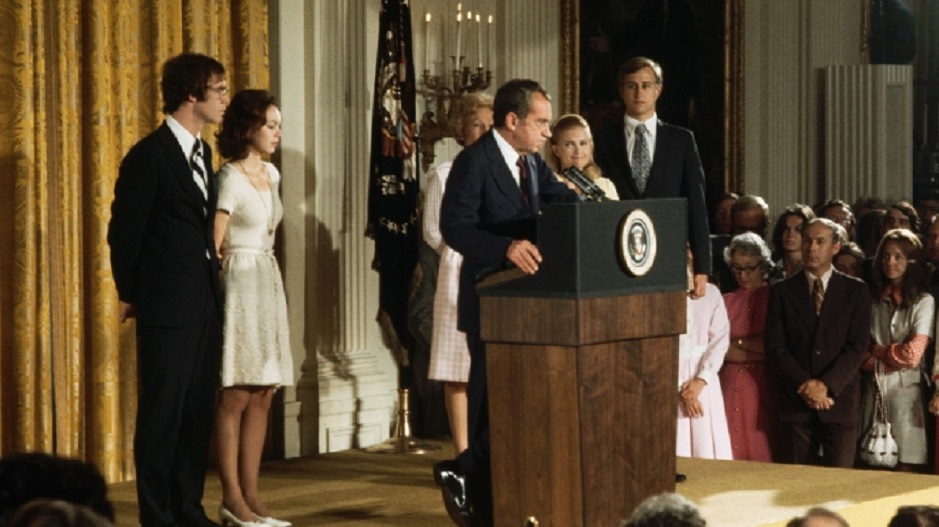
 President
Richard M. Nixon Resigns, Washington, D.C., August 1974 - Nixon
resigned the presidency on August 9, saying farewell to his Cabinet and
White House staff with his family by his side.The emotion on Nixon's,
and his families faces is amazing. That look of disgust from his son,
and how is daughter look down in shame.
President
Richard M. Nixon Resigns, Washington, D.C., August 1974 - Nixon
resigned the presidency on August 9, saying farewell to his Cabinet and
White House staff with his family by his side.The emotion on Nixon's,
and his families faces is amazing. That look of disgust from his son,
and how is daughter look down in shame.
Richard Nixon became the first United States president to resign from office on August 9, 1974. The Nixon administration’s attempt to cover up the break-in at the Democratic National Committee headquarters on June 17, 1972 eventually cost Nixon the presidency. The investigation conducted by the Watergate Committee revealed that President Nixon had a tape recording system in the Oval Office. After several court battles the Supreme Court unanimously ruled that the president must hand over the tapes. Between July 27, 1974 and July 30, 1974 the House Judiciary Committee approved three articles of impeachment against President Nixon: obstruction of justice, abuse of power and contempt of Congress. The House Judiciary Committee formally impeached Nixon on August 20, 1974, 11 days after his resignation.

